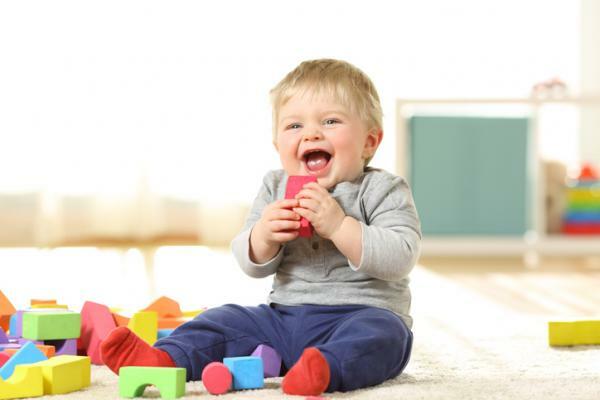
Early stimulation consists of providing children with activities that strengthen and promote their optimal neurodevelopment. Early stimulation is useful and it is common to use it when it comes to children with some type of disability (visual, auditory, intellectual, ...) or susceptible to suffering from it. Although it is also very practical to carry out early stimulation activities with all children between 0 and 8 years old, whether or not they have a disability or neurodevelopmental disorders. If you are a mother or father, it may be very interesting to read this article from Psychology-Online: early stimulation exercises for babies.
Index
- What is early intervention
- Areas of early stimulation
- Early stimulation for premature babies
- Examples of early stimulation exercises
What is early intervention.
The brain of children when they are born is equivalent to a blank book, therefore, the objective of the early stimulation exercises revolves around writing the pages of this book. This would be a metaphor that makes it very clear that people start from scratch when they are born but as their neurons become interconnected, their capacities increase, therefore, with early stimulation, aims to
On the one hand, there are neurons that are already connected when the baby is born, such as the neural connections that allow breathing, the heartbeat, among others. However, on the other hand, there are other neurons that, if not connected, would not be useful for the baby and, therefore, must be stimulated to favor the connection of it.
The optimal time to stimulate the child's neurons is his first years of life, approximately from birth to eight years. Once these first years of the child's life have passed, it will still be possible to stimulate neural connections, although it will be more complicated since the neuron circuits will have already been created during the previous years and no circuits can be created new.
Areas of early stimulation.
What areas does early stimulation cover? There are different areas of development that can be stimulated or activated through early stimulation exercises, and each of them must be stimulated depending on the child's age. The areas of development of early stimulation are:
- Sensory development: stimulate the five senses. It includes visual, auditory, tactile, gustatory and olfactory stimulation.
- Motor development: stimulate movement and coordination skills. It includes the stimulation of fine motor skills, gross motor skills, knowledge of one's own body scheme, coordination and laterality (left / right) and expressive possibilities.
- Cognitive development: stimulate the child's intellectual capacity, it should be noted that reading and writing play a very important role. Includes stimulation of creativity, logical reasoning, spatial orientation (in space and time), attention selective, memory, observation, calculation and numerical concepts, affective and emotional development and sociability.
- Linguistic development: stimulate the ability of language, a fundamental ability to develop intelligence, given the close relationship between language acquisition and cognitive development. It is very important to stimulate this ability around the age of six, when children are in the process of learning to read and write. It includes the stimulation of oral expression, written expression and literacy.
- Development and acquisition of behavioral habits: stimulate the child's personality, including order, sincerity, generosity, responsibility and many other values. It is an equally important stimulation, centered on your personality.
Early stimulation for premature babies.
A premature baby is one that is born before reaching 37 normative weeks of gestation, equivalent to nine months of pregnancy. Being born prematurely is a risk factor for deficiency and / or disability. Prematurity also leads to a high risk of suffering pervasive developmental disorders motor, psychic and sensory, which often cause learning difficulties. In addition, the repercussions at the family and social level that these risks cause must also be taken into account, although if correct treatment and follow-up were done, most premature babies could have a normal long-term evolution term.
Thus, with a high probability of suffering neurodevelopmental alterations, early stimulation for premature babies is very advantageous to promote neurodevelopment. The most common treatment in premature babies is early stimulation, physical therapy, speech therapy, supports and adaptations in pediatric education and monitoring. Therefore, it is a joint work, between different professionals.

Examples of early stimulation exercises.
We have already seen what early stimulation is, what areas it covers and also how useful it is in the case of premature babies. But how is early stimulation done? Here are examples of early stimulation exercises for babies, whether for premature babies or not:
- Exercise to stimulate eyesight: we choose an object, not very big, that catches the baby's attention (because of its color, shape ...), we place it in his field of vision, about 20-30 centimeters away, we move it slowly from left to right and from top to bottom, with the intention that the baby follows the path of the object with his eyes and, thus, can put eye movement into practice. This early stimulation exercises is usually performed between the ages of 0 and 3.
- Exercise to stimulate fine motor skills: provide the child with a few lentils (or very small objects, such as pellets) and a bottle. The exercise that the child must perform consists of putting all the lentils into the bottle, one by one, and taking them with the fingers of the hands. It is very important to ensure that the child does not eat the lentils or put them in the nose. This early stimulation exercises is customary to perform between 4 and 6 years.
- Exercise for stimulate memory: with a cardboard, scissors and some markers, you can create a fun game for your child that will also stimulate their memory. You cut the cardboard into squares, and in these squares you draw objects (ball, sock ...) so that you have two pictures of each object. Once the square cards are finished, the game is ready. How do you play? In front of the child you put the cards face down and untidy, then the child must find the pairs. He must pick up two cards and if they don't match he turns them face down again, and so on. This early stimulation exercise is quite well known, you can buy it or create your own game and personalize the drawings with what your children like.
This article is merely informative, in Psychology-Online we do not have the power to make a diagnosis or recommend a treatment. We invite you to go to a psychologist to treat your particular case.
If you want to read more articles similar to Early Stimulation Exercises for Babies, we recommend that you enter our category of Learning disorders.
Bibliography
- Martínez, C.F., García, P., Poblano, A., and Madlen, M.Á. (2010). Early stimulation of hearing and language for children at high risk of neurological sequelae. Acta Pediátrica de México, 31 (6), 304-310.
- Pallás, C.R., De la cruz, J., and Medina, M.C. (2000). Support for the development of children born too young, too early. Ten years of observation and clinical research in the context of a follow-up program.
- Regidor, R. (2005). The capacities of the child, early stimulation guide from 0 to 8 years. Second edition. Madrid: Ediciones Palabra, S.A.
- Rellan, S., García, C., and Aragón, M.P. (2008). The premature newborn. Spanish Association of Pediatrics.


